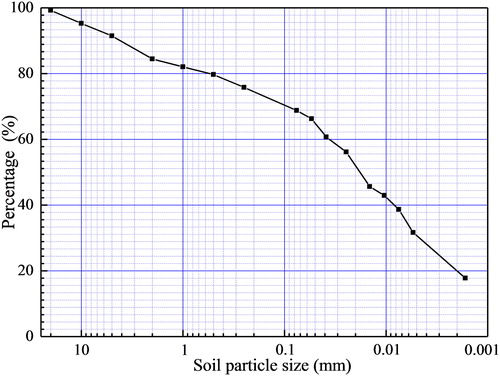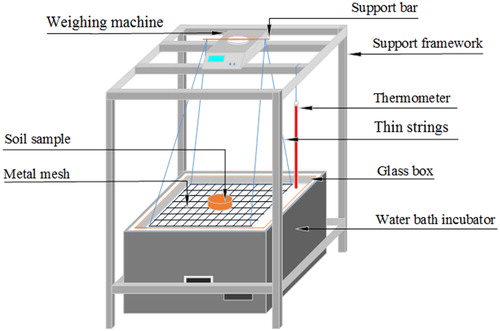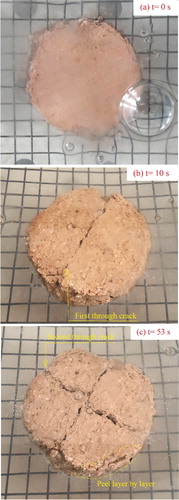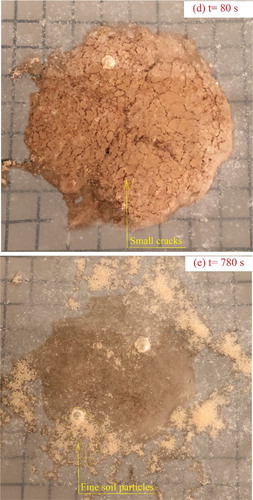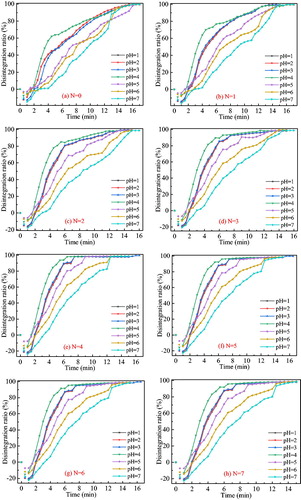 ?Mathematical formulae have been encoded as MathML and are displayed in this HTML version using MathJax in order to improve their display. Uncheck the box to turn MathJax off. This feature requires Javascript. Click on a formula to zoom.
?Mathematical formulae have been encoded as MathML and are displayed in this HTML version using MathJax in order to improve their display. Uncheck the box to turn MathJax off. This feature requires Javascript. Click on a formula to zoom.Abstract
Granite residual soil has obvious disintegration characteristics, resulting in serious water and soil losses in South China. There is a lack of studies on the disintegration of granite residual soil. Therefore, it is important to determine the disintegration characteristics of granite residual soil, especially under combined influence of wetting–drying cycles and acid rain. Granite residual soil from Jinqiao Village, Yudou County of South China, was used as experimental material. The disintegration velocity was evaluated to investigate the effects of wetting–drying cycles and acid rain on soil disintegration characteristics. Under the pH conditions of acid rain, disintegration velocity increases as the number of wetting–drying cycles increases (from 0 to 4), reaches a maximum after four wetting–drying cycles; then remains relatively constant as the wetting–drying cycle number increases from 4 to 7. Meanwhile, under conditions of a given wetting–drying cycle number, disintegration velocity increases with the decrease in pH from 7 to 4, reaches a maximum at a pH of 4, and then remains relatively constant when the pH decreases from 4 to 1. Moreover, the disintegration velocity under the combined influence of wetting–drying cycles and acid rain is considerably higher than that under individual factor.
1. Introduction
Soil disintegration involves soil dispersion and fragmentation, which occur because the repulsive forces between the soil particles are larger than the cohesive forces between them, and depends on several factors (Zhang et al. Citation2016; Liu et al. Citation2019b). Granite residual soil, which contains more than 60% fine soil particles, is widely distributed in the soil erosion region of South China. The main minerals of granite residual soil are quartz, kaolinite and gibbsite (Kong et al. Citation2018; Liu et al. Citation2019a). Granite residual soil has the following mechanical characteristics: a loose structure, moderate compressibility and low shear strength. Owing to these characteristics, granite residual soil occurs in the soil erosion region in South China commonly disintegrates, leading to water and soil losses, the destruction of natural ecosystem and economic losses (Liu et al. Citation2013; Ollobarren et al. Citation2016; Huang et al. Citation2017b, Citation2017d; Li et al. Citation2017; Wu et al. Citation2017; Huang et al. Citation2018b). Therefore, it is necessary to study the disintegration characteristics of granite residual soil in South China.
Many studies have been carried out on rock disintegration worldwide (Erguler and Shakoor Citation2009; Erguler and Ulusay Citation2009; Mohamad et al. Citation2011; Huang et al. Citation2018b). However, only a few previous studies have focussed on soil disintegration. Siebers et al. (Citation2018) studied disintegration of different top soils (i.e. long-term forest, grassland, arable soil). Fajardo et al. (Citation2016) described the slaking of the soil collected from New South Wales, Australia. Xiao et al. (Citation2017) investigated the effect of the slaking of various soils, such as loamy clay, clay loam and sandy loamy soil on the splash erosion. In addition, Xiao et al. (Citation2018) explored the aggregate disintegration mechanisms of different soils from the Chinese loess Plateau of China. Taylor et al. (Citation2018) studied the disintegration of lunar Apollo soils.
There is a lack of studies focussing on the effects of wetting–drying cycles and acid rain on the disintegration characteristics of granite residual soils compared with other soil types, although wetting–drying cycle and acid rain are two very important factors affecting the soil disintegration (Pasculli et al. Citation2017; Huang et al. Citation2018a; Lu et al. Citation2018). Wu and Wang (2000) studied the disintegration by analysing the chemical composition and structure of granite residual soil. Yan et al. (Citation2009) investigated the disintegration mechanism of granite residual soil depending on internal factor, such as particle suction and external causes. Zhang and Tang (Citation2013) analysed the disintegration mechanism of granite residual soil depending on matrix suction. With respect to factors influencing the soil disintegration, Liu C. et al. (Citation2016) conducted experiments to observe the effects of wetting–drying cycle on the fracture development of granite residual soils. However, most of these studies mainly focussed on the disintegration characteristics of granite residual soils from the aspects of micromechanics and/or depending on a single macro influencing factor, rather than the combination of several factors. Therefore, it is necessary to explore the combined effects of macro influencing factors (i.e. wetting–drying cycle and acid rain) on the disintegration velocity of granite residual soils.
The disintegration of granite residual soil is one of the main factors affecting soil erosion in South China (Xu Citation1996; Liu et al. Citation2016; Huang et al. Citation2017a; Liu et al. Citation2018). The disintegration of these granite residual soils is significantly affected by the heavy rainfall and acid rain (He et al. Citation2000; Larssen and Carmichael Citation2000; Huang et al. Citation2017c; Li et al. Citation2017, Citation2018). Hence, this research aims to thoroughly study the disintegration characteristics of granite residual soils under the combined influence of heavy rainfall and acid rain. The research results provide a theoretical basis for understanding and controlling soil erosion.
2. Materials and methods
2.1. Experimental materials
The granite residual soils from Jinqiao Village (25°59″24″N, 115°26′32″E), Yudou County, Jiangxi Province, South China, were used as experimental material in this study. Samples were collected from a depth of 0.5 m below the ground surface. The physical and geotechnical properties of the granite residual soil are summarized in and the grain size distribution curve is given in .
Table 1. Physical and geotechnical properties of granite residual soil.
2.2. Experimental disintegration device
An experimental disintegration device was used for the disintegration experiments. The schematic diagram of this experimental device is shown in . This experimental device consists of three parts: (1) a support system, including support framework, thin strings, metal mesh and support bar; (2) a temperature control system, including water bath incubator, glass box and thermometer; and (3) data collection system, including weighing machine.
The glass box has a size of approximately 238 mm × 238 mm × 90 mm and a capacity of 5381.18 ml. The grid size of the metal mesh supporting the soil samples is 9 mm × 9 mm. The metal mesh is connected to the weighing machine via the thin strings and support bar.
2.3. Experimental scheme
South China is characterized by a subtropical humid monsoon climate with frequent heavy rainfall and exposure to sunlight. Hence, wetting–drying cycles, that is, alternating soil moisture saturation and water loss, can be used to effectively simulate the soil loss of the granite residual soil loss in the dry season and water absorption in the rainy season (Kalkan Citation2011; Chen and Ng Citation2013; Huang et al. Citation2016a, Citation2016b). Furthermore, South China is greatly affected by acid rain, which contributes to loss of rock components such as calcium and magnesium (Zhao et al. Citation2018). Acid rain can also lead to soil acidification and soil disintegration (Zhang and Mcsaveney Citation2018). Hence, this research aims to thoroughly explore the disintegration characteristics of granite residual soil under the combined influence of different wetting–drying cycles and acidic solution with different pH values.
In this study, acidic solutions with different pH values were used to simulate the acid rain. The experimental schemes of this study are shown in . The number of wetting–drying cycles (N) was set to 0, 1, 2, ……. and 7, respectively, and the pH value of the solution was set to respectively 7, 6, 5, …., and 1, respectively. Hence, a total of 56 different experimental conditions were obtained based on the different numbers of wetting–drying cycles and solutions with different pH values. These 56 experiments were designed to simulate the disintegration of granite residual soil under the combined influence of wetting–drying cycle and acid rain. To ensure the accuracies of experiment results, each of these experiments were repeated for thrice.
Table 2. Experimental schemes.
2.4. Experimental method
During the experiments, the temperature of the acid solution in the glass box was set to 25 °C. After the wetting–drying cycles, disintegration experiments were performed in the glass box using the acid solution. The experiment was started when the soil sample was completely submerged in the solution and touched the metal mesh. The weighing machine recorded data every 1/6 min (10 s). The experiment was stopped when the measuring data of the weighing machine were close to zero and remained constant (GroßE et al. Citation2015). Finally, the recorded data were stored and analysed.
2.4.1. Anti-acid corrosion measures
Metal mesh corrodes when it is submerged in the acidic solution, which leads to an experimental error. Hence, the metal mesh was completely sprayed with acid proof paint to prevent the acid corrosion.
2.4.2. Preparation of the soil samples
The granite residual soil was sieved using a 2 mm mesh sieve. Standard samples of the sieved soil were then prepared using a cutting ring with an inner diameter of 61.8 mm and a height of 20 mm. In addition, the dry density and initial moisture content of the standard samples were determined; they are 1.6 g/cm3 and 20%, respectively as shown in .
2.4.3. Preparation of acid solution with different pH values
Acid rain in South China is mainly sulphuric rain with the following proportion of sulphate and nitrate ions: Hence, in this study, an acid solution with the following proportion was prepared:
The pH values were adjusted to 1, 2, 3, 4, 5, 6, and 7.
2.4.4. Implementation of wetting–drying cycles
For the wetting–drying cycles, the standard soil samples were first saturated for 48 h using the vacuum saturation method. The saturated samples were then dried in an oven at 105 °C and the moisture content of the dried samples was determined and used as initial moisture content (20%). Subsequently, one wetting–drying cycle was implemented for the standard soil samples (DöRner et al. Citation2009). Similarly, multiple wetting–drying cycles can be implemented.
2.4.5. Quantitative calculation of disintegration characteristics
In this study, the concept of the disintegration ratio was used to describe the disintegration characteristics of granite residual soil:
(1)
(1)
where
represents the disintegration ratio of the soil sample at time
is the reading of the weighting machine at the time at which the soil samples was initially submerged in the acid solution, and
represents the reading of the weighting machine at time
The unit of
and
is gram (
). The concept of the disintegration velocity
was used to describe the disintegration speed of the soil samples:
(2)
(2)
where
represents the disintegration ratio at time
represents the disintegration ratio at time
and the
denotes the disintegration velocity from
to
in unit of %/min.
3. Experimental results
3.1. Typical disintegration processes of soil samples
In the experimental processes, it was found that the most obvious disintegration phenomenon of soil samples occurs under the conditions of wetting–drying cycles number N = 4 and acid rain pH = 4 comparing to other conditions (). The most obvious disintegration phenomenon is identified based on the development features of the main and secondary intermittent cracks in the soil samples.
Figure 3. Typical disintegration of soil samples at N = 4 and pH = 4.
At t = 0 s, bubbles appear in the soil sample, suggesting that the solution is absorbed by the soil sample (). The absorption is due to the occurrence of pores and fissures in the soil after the fourth wetting–drying cycle, which accelerate the water migration in the soil sample (Jasinska et al. Citation2006). In addition, the dissolution of soluble material (e.g. sodium and potassium) in the soil sample is lower than the absorption of hydrotropic substances (e.g. kaolinite) and pores. Therefore, the reading of the weighing machine increases at the initial stage of the experiment.
At a disintegration phenomenon time t = 10 s, the first through crack occurs in the soil sample, with soil caving at both ends of the crack (). The reasons for this were listed as the following three points: (i) the effective stress in the soil sample decreases because the pores in the soil sample are filled with solution and the connections between the soil particles are weakened; (ii) soil swelling occurs in the soil sample after the solution infiltrated into the pores and cracks of the soil samples, which leads to the generation of fracture stress (Stoltz et al. Citation2014; Guo et al. Citation2019) and (iii) the stability of soil sample declines because of the wetting–drying cycles (Jiang et al. Citation2018).
At t = 53 s, the second through crack occurs in the soil sample and the soil sample gradually disintegrates from the edge to the inside, that is, it is peeling off layer by layer (). The soil sample broke down into four roughly uniform parts, and each part is broke down into new sub–parts circularly.
At t = 80 s, a large amount of soil caving occurred at the edge of cracks and the main cracks gradually become obscure (). In addition, more small cracks occurred on the soil surface, which accelerate the soil disintegration.
The disintegration experiment was almost completed at t = 780 s (). Most of the soils are disintegrated down in the bottom of the glass box under the metal mesh. In addition, the solution gradually becomes turbid, and several fine soil particles rise with the bubbles and float on the solution surface.
3.2. Effects of the wetting–drying cycles on the soil disintegration
shows the soil disintegration characteristics influenced by the combined action of different numbers of wetting–drying cycles and acid solutions with different pH values. The disintegration of the soil samples can be divided into three phases: initial stage, rapid stage and stable stage. The disintegration ratio vs. time are S–shaped. At a given pH value, the disintegration velocity increases with the increasing numbers of wetting–drying cycles (from 0 to 4) and reaches a maximum after four wetting–drying cycles. Subsequently, the disintegration velocity remains relatively constant with the increase in the numbers of wetting–drying cycles increase from 4 to 7.
provides an example of the disintegration development at pH = 4 and N = 0, 1, 2……,7. The equations for the linear regression lines of disintegration ratio vs. time curves in the rapid disintegration stage at pH = 4 and N = 0, 1, 2……7 are shown in . Based on the equations, is 19.96%/min, 21.32%/min, 22.89%/min, 27.09%/min, 30.60%/min, 28.09%/min, 30.43%/min and 30.53%/min at pH = 4 and N = 0, 1, 2……7, respectively. It can also be seen from that the slope of disintegration ratio vs. time curve in the stable disintegration stage at
was higher than that under other conditions.
Table 3. of the soil samples in the rapid stage.
These disintegration characteristics can be explained as follows: first, the soil samples yield smaller elastic modulus and higher deformation values than other untreated soil samples, which is due to the wetting–drying cycles (Rasul et al. Citation2018). Therefore, the of the soil samples increases with the increase in the number of wetting–drying cycles from 0 to 4. On the other hand, the weakening effect of the cohesion between the soil particles of the soil sample reached a maximum after four wetting–drying cycles (Wang et al. Citation2017). Hence, the
reached a maximum and then remains stable with the increase in the number of wetting–drying cycle increase from 4 to 7.
The correlations between the disintegration ratio and time in the rapid stage are linear, as shown in and . A linear regression was used to fit the disintegration ratio vs. time curves in rapid stage in this study and the disintegration velocity was obtained from the tangent slope.
3.3. Effects of acid rain on disintegration
The effects of the pH value of the acid solution on the disintegration velocity of the soil samples are shown in . At a given wetting–drying cycle number, the of the soil sample increases when the pH value decreases from 7 to 4, reaches a maximum at a pH of 4, and then remains relatively constant when the pH value decreases from 4 to 1. shows that the rapid stage of soil disintegration begins at t = 1.5, 1.5, 1.5, 1.0, 1.5, 1.5 and 1.5 min and ends at t = 6.5, 6.5, 6.5, 4.5, 6.0, 6.0 and 6.0 min at a pH of 7, 6, 5, 4, 3, 2 and 1, respectively. The corresponding disintegration ratio is 39.91%, 58.32%, 75.52%, 89.37%, 85.50%, 85.02% and 84.86%, respectively. Based on the linear regression, the disintegration velocity is 11.11%/min, 13.03%/min, 15.22%/min, 27.09%/min, 24.21%/min, 24.25%/min, 24.26%/min at a pH of 7, 6, 5, 4, 3, 2 and 1, respectively. The highest disintegration velocity was recorded at a pH of 4. The disintegration ratio vs. time curves generally overlap at a pH of 1, 2 and 3.
These disintegration characteristics can be explained as follows: The SiO2, Al2O3 and Fe2O3 contents of the granite residual soil are higher than 80%, and the leaching effect of SiO2, Al2O3 and Fe2O3 from the granite residual soil results in a lack of cohesive force between soil particles (Sunil et al. Citation2006). Furthermore, the mineral structure might significantly change because of the dissolution of alumina and silica under the acidic condition. Therefore, acid rain contributes to the disintegration of the soil.
In addition, the minerals (e.g. quartz, kaolinite and gibbsite) in the soil samples are dissolved faster by acid solution with the decrease in the pH values from 7 to 4, which reduces the soil mechanical strength of the soil samples and speeds up the disintegration velocity (Bakhshipour et al. Citation2016). The dissolution of minerals in the soil sample by acid solution reaches a maximum pH value of 4. Hence, the disintegration velocity of the soil samples remains relatively stable when the pH value decreases from 4 to 1.
4. Discussion
To explore the effects the combined influence of wetting–drying cycles and acid rain on the disintegration of granite residual soil, a three-dimensional (3D) curved surface map is drawn in based on and . The first, second- and third-dimensional coordinates represent the pH value of the acid solution, number of wetting–drying cycles N, and disintegration velocity respectively.
Figure 6. 3D curved surface map of pH value, number of wetting–drying cycles and disintegration velocity.
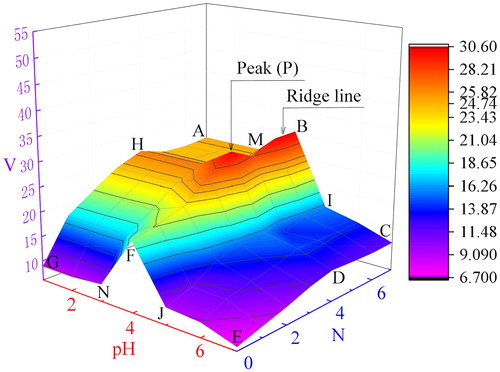
It can be seen from that the whole 3D map has a ‘ridge’ shape. The coordinates of some feature points are A (7, 1, 24.97), B (7, 4, 30.53), C (7, 7, 11.78), D (4, 7, 12.22), E (0, 7, 6.79), F (0, 4, 19.96), G (0, 1, 8.84), H (4, 1, 26.27) and P (4, 4, 30.60). Furthermore, point P is the maximum of the 3D map, illustrating that the maximum is 30.60%/min when the number of wetting–drying cycles is 4 and the pH value is 4; the point E is the minimum of the 3D map, suggesting that the minimum disintegration velocity is 6.79%/min when the number of wetting–drying cycles is 0 and the pH value is 7. It can be concluded that the effects of the combined influence of acid rain and wetting–drying cycles on disintegration velocity of the soil specimens are stronger than the effect based on the influence of a single factor, that is, acid rain or wetting–drying cycle.
also shows that, the BPF curve, corresponding to a pH = 4 and N = 0, 1, 2……and 7 is the ‘ridge line’ of the 3D map. The ‘ridge line’ divides the 3D curved surface into two parts: surface ABFG (containing surfaces AMNG and MBFN) and surface BCEF (containing surfaces BIJF and ICEJ). The AMNG curved surface shows that the contour lines of the surface are basically parallel to the pH coordinate axis at a pH of 1–3 and N = 0, 1, 2, …, 7. This indicates that N has a dominant effect on the disintegration velocity. Similarly, the BIJF curved surface shows that the pH value has a major effect on the disintegration velocity at a pH of 4–5 and N = 0, 1, 2……7. The angle between the contour lines and pH coordinate axis or number of wetting–drying cycles N is about 45° at a pH of 5–7 and N of 0–4, indicating that almost identical effects of the pH and N on the disintegration velocity.
5. Conclusion
To study the effects of combined influence of wetting–drying cycles and acid rain on the disintegration of granite residual soil in the soil erosion area of South China, disintegration experiments are carried out on granite residual soil using different numbers of wetting–drying cycles and solutions with different pH values of acid rain. The following conclusions can be drawn:
At a set pH value of acid rain, the disintegration velocity increases with the increase in the number of wetting–drying cycles from 0 to 4, reaches a maximum after four wetting–drying cycles, and then remains relatively constant when the wetting–drying cycle numbers increase from 4 to 7.
At a set wetting–drying cycle number, the disintegration velocity increases when the pH value of the solution decreases from 7 to 4, reaches a maximum when the pH value is 4, and then remains approximately the same as the pH value decreases from 4 to 1.
The disintegration velocity of granite residual soils under the combined influence of wetting–drying cycles and acid rain is considerably higher than that based on the influence of a single factor, that is, wetting–drying cycle or acid rain.
Disclosure statement
No potential conflict of interest was reported by the authors.
Additional information
Funding
References
- Bakhshipour Z, Asadi A, Huat BBK, Sridharan A, Kawasaki S. 2016. Effect of acid rain on geotechnical properties of residual soils. Soils Found. 56(6):1008–1020.
- Chen R, Ng CWW. 2013. Impact of wetting–drying cycles on hydro-mechanical behavior of an unsaturated compacted clay. Appl Clay Sci. 86(8):38–46.
- DöRner J, Dec D, Peng X, Horn R. 2009. Change of shrinkage behavior of an andisol in southern Chile: effects of land use and wetting/drying cycles. Soil Tillage Res. 106(1):45–53.
- Erguler ZA, Shakoor A. 2009. Relative contribution of various climatic processes in disintegration of clay-bearing rocks. Eng Geol. 108(1–2):36–42.
- Erguler ZA, Ulusay R. 2009. Assessment of physical disintegration characteristics of clay-bearing rocks: disintegration index test and a new durability classification chart. Eng Geol. 105(1–2):11–19.
- Fajardo M, Mcbratney AB, Field DJ, Minasny B. 2016. Soil slaking assessment using image recognition. Soil Tillage Res. 163:119–129.
- GroßE AK, CantrE S, Saathoff F. 2015. The applicability of disintegration tests for cohesive organic soils. J Environ Eng Landsc Manag. 23(1):1–14.
- Guo Z, Yin K, Gui L, Liu Q, Huang F, Wang T. 2019. Regional rainfall warning system for landslides with creep deformation in three gorges using a statistical black box model. Sci Rep. 9(1):8962.
- He J-L, Chen HW, Xiao-Hua HU, Chen K. 2000. On the influent factors for the formation of severe acid rain band in Jiangxi province. China Environ Sci. 20(5):477–480.
- Huang F, Chen L, Yin K, Huang J, Gui L. 2018a. Object-oriented change detection and damage assessment using high-resolution remote sensing images, Tangjiao landslide, three gorges reservoir, China. Environ Earth Sci. 77(5):183.
- Huang F, Huang J, Jiang S, Zhou C. 2017b. Landslide displacement prediction based on multivariate chaotic model and extreme learning machine. Eng Geol. 218:173–186.
- Huang F, Huang J, Jiang S-H, Zhou C. 2017a. Prediction of groundwater levels using evidence of chaos and support vector machine. J Hydroinform. 19(4):586–606.
- Huang F, Luo X, Liu W. 2017c. Stability analysis of hydrodynamic pressure landslides with different permeability coefficients affected by reservoir water level fluctuations and rainstorms. Water. 9(7):450.
- Huang F, Yao C, Liu W, Li Y, Liu X. 2018b. Landslide susceptibility assessment in the Nantian area of China: a comparison of frequency ratio model and support vector machine. Geomat Nat Haz Risk. 9(1):919–938.
- Huang F, Yin K, He T, Zhou C, Zhang J. 2016a. Influencing factor analysis and displacement prediction in reservoir landslides − a case study of three gorges reservoir (China). Tehnički Vjesnik. 23(2):617–626.
- Huang F, Yin K, Huang J, Gui L, Wang P. 2017d. Landslide susceptibility mapping based on self-organizing-map network and extreme learning machine. Eng Geol. 223:11–22.
- Huang F, Yin K, Zhang G, Gui L, Yang B, Liu L. 2016b. Landslide displacement prediction using discrete wavelet transform and extreme learning machine based on chaos theory. Environ Earth Sci. 20(75):1–18.
- Jasinska E, Wetzel H, Baumgartl T, Horn R. 2006. Heterogeneity of physico-chemical properties in structured soils and its consequences. Pedosphere. 16(3):284–296.
- Jiang S-H, Huang J, Huang F, Yang J, Yao C, Zhou C-B. 2018. Modelling of spatial variability of soil undrained shear strength by conditional random fields for slope reliability analysis. Appl Math Model. 63:374–389.
- Kalkan E. 2011. Impact of wetting–drying cycles on swelling behavior of clayey soils modified by silica fume. Appl Clay Sci. 52(4):345–352.
- Kong LW, Hossain MS, Tian H. 2018. Influence of drying–wetting cycles on soil-water characteristic curve of undisturbed granite residual soils and microstructure mechanism by nuclear magnetic resonance (NMR) spin-spin relaxation time (t 2) relaxometry. Can Geotech J. 55(2):208–216.
- Larssen T, Carmichael GR. 2000. Acid rain and acidification in China: the importance of base cation deposition. Environ Pollut. 110(1):89–102.
- Li Y, Huang J, Jiang S-H, Huang F, Chang Z. 2017. A web-based gps system for displacement monitoring and failure mechanism analysis of reservoir landslide. Sci Rep. 7(1):17171.
- Li W, Ren HC, Zuo J, Ren HL. 2018. Early summer southern China rainfall variability and its oceanic drivers. Clim Dyn. 50(11–12):4691–4705.
- Liu W, Luo X, Huang F, Fu M. 2019a. Prediction of soil water retention curve using Bayesian updating from limited measurement data. Appl Math Model. 76:380–395.
- Liu C, Pan J, Deng Y, Zhao Y, Ding S. 2016. The influence of wet-dry cycles on collapsing gully soil stability. J Soil Water Conserv. 30(6):253–258.
- Liu X, Qiu J, Zhang D. 2018. Characteristics of slope runoff and soil water content in benggang colluvium under simulated rainfall. J Soils Sediment. 18(1):39–48.
- Liu W, Wan S, Huang F, Luo X, Fu M. 2019b. Experimental study of subsurface erosion in granitic under the conditions of different soil column angles and flow discharges. Bull Eng Geol Environ. 1–12.DOI: 10.1007/s10064-019-01519-w
- Liu H, Zhang T, Liu B, Liu G, Wilson GV. 2013. Effects of gully erosion and gully filling on soil depth and crop production in the black soil region, northeast China. Environ Earth Sci. 68(6):1723–1732.
- Liu W, Luo X, Fu M, Huang J. 2016. Experiment and modeling of soil-water characteristic curve of unsaturated soil in collapsing erosion area. Pol J Environ Stud. 25(6):2509–2517.
- Lu G, Tian H, Liu Y, Naidu R, Wang Z, He W. 2018. Using Qmsax* to evaluate the reasonable As(V) adsorption on soils with different pH. Ecotoxicol Environ Saf. 160(30):308–315.
- Mohamad ET, Saad R, Abad SVANK. 2011. Durability assessment of weak rock by using jar slaking test. Electron J Geotech Eng. 16:1319–1335.
- Ollobarren P, Capra A, Gelsomino A, Spada CL. 2016. Effects of ephemeral gully erosion on soil degradation in a cultivated area in Sicily (Italy). Catena. 145:334–345.
- Pasculli A, Sciarra N, Esposito L, Esposito AW. 2017. Effects of wetting and drying cycles on mechanical properties of pyroclastic soils. Catena. 156:113–123.
- Rasul JM, Ghataora GS, Burrow MPN. 2018. The effects of wetting and drying on the performance of stabilized subgrade soils. Transp Geotech. 14:1–7.
- Siebers N, Abdelrahman H, Krause L, Amelung W. 2018. Bias in aggregate geometry and properties after disintegration and drying procedures. Geoderma. 313:163–171.
- Stoltz G, Cuisinier O, Masrouri F. 2014. Weathering of a lime-treated clayey soil by drying and wetting cycles. Eng Geol. 181(1):281–289.
- Sunil BM, Nayak S, Shrihari S. 2006. Effect of pH on the geotechnical properties of laterite. Eng Geol. 85(1–2):197–203.
- Taylor LA, Hogancamp JV, Watts LA, Wentworth SJ, Basu A. 2018. Disintegration of lunar samples over time: a test. Meteorit Planet Sci. 53(5):1096–1103.
- Wang C, Zhang ZY, Liu Y, Fan SM. 2017. Geometric and fractal analysis of dynamic cracking patterns subjected to wetting-drying cycles. Soil Tillage Res. 170:1–13.
- Wang WZF. 2000. Relationship between slope disintegration and rock soil characteristics of granite weathering mantle in south China. J Soil Water Conserv. 14(2):31–35.
- Wu LZ, Zhou Y, Sun P, Shi JS, Liu GG, Bai LY. 2017. Laboratory characterization of rainfall-induced loess slope failure. Catena. 150:1–8.
- Xiao H, Gang L, Zhang Q, Zheng F, Zhang X, Puling L, Jiaqiong Z, Feinan H, Mohamed AM, Elbasit A. 2018. Quantifying contributions of slaking and mechanical breakdown of soil aggregates to splash erosion for different soils from the Loess Plateau of China. Soil Tillage Res. 178:150–158.
- Xiao H, Liu G, Abd-Elbasit MAM, Zhang XC, Liu PL, Zheng FL, Zhang JQ, Hu FN. 2017. Effects of slaking and mechanical breakdown on disaggregation and splash erosion. Eur J Soil Sci. 68(6):797–805.
- Xu J. 1996. Benggang erosion: the influencing factors. Catena. 27(3–4):249–263.
- Yan B, Tang LS, Hui HU, Wang DZ, Lin GW. 2009. The mechanism of disintegration damage of granite weathered soil. Hydrogeol Eng Geol. 53(6):68–84.
- Zhang XW, Kong LW, Chen C, Yin S. 2016. Experimental investigation on relative contribution of hot and humid weather and heavy rainfall in disintegration of basalt residual soil. Sci Sin-Tech. 46(11):1175–1184.
- Zhang M, Mcsaveney MJ. 2018. Is air pollution causing landslides in China? Earth Planet Sci Lett. 481:284–289.
- Zhang S, Tang H. 2013. Experimental study of disintegration mechanism for unsaturated granite residual soil. Rock Soil Mech. 34(6):001668–001674.
- Zhao JX, Lu CH, Deng LM, Liu GC. 2018. Impacts of simulated acid solution on the disintegration and cation release of purple rock (mudstone) in southwest China. Geomorphology. 316:35–43.

